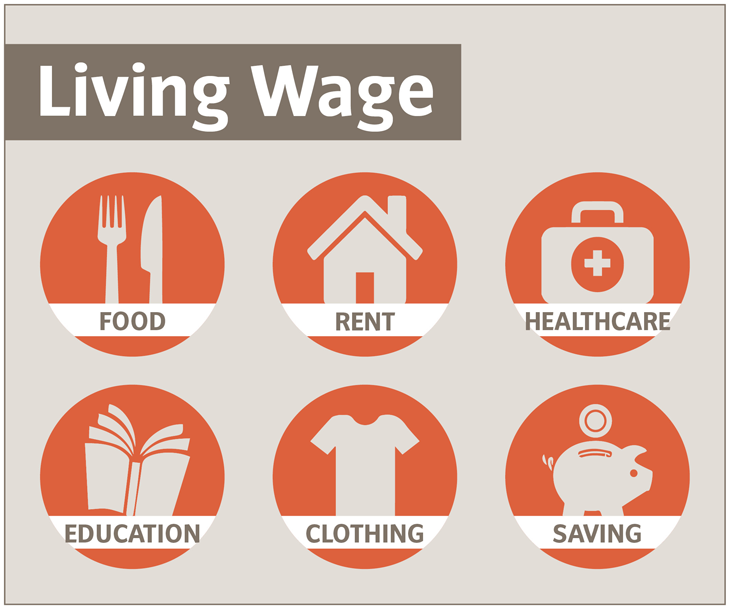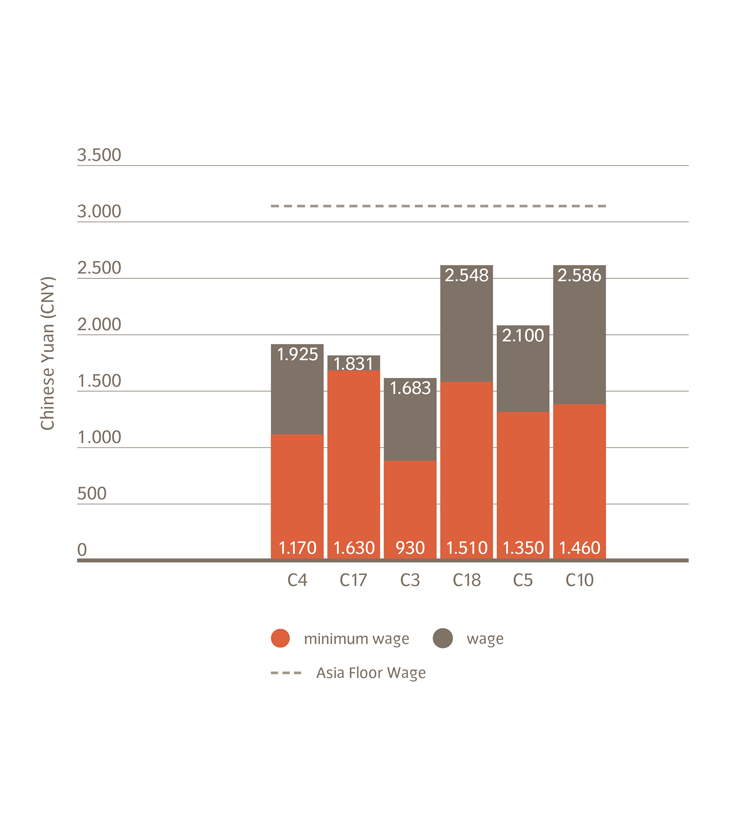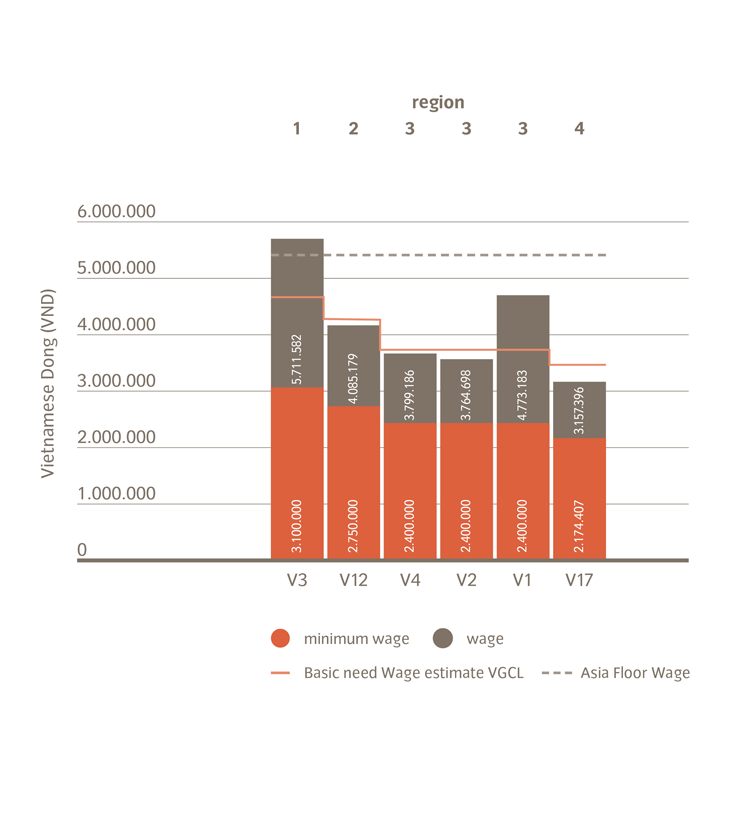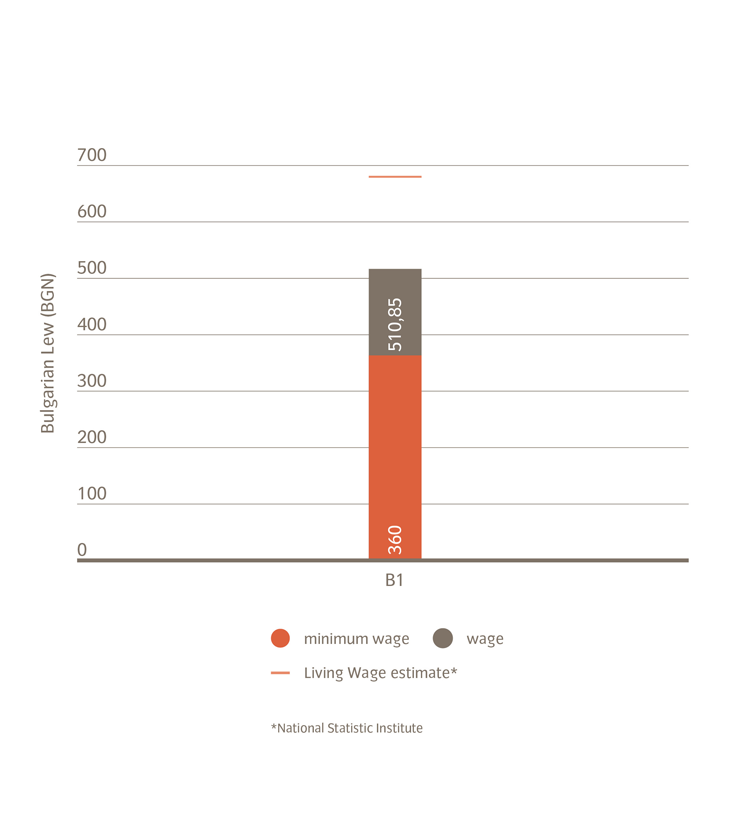
A living wage
What we require from our production partners
Wages and benefits paid for a standard working week shall meet at least legal or industry minimum standards and always be sufficient to meet basic needs of workers and their families and to provide some discretionary income. Deductions from wages for disciplinary measures shall not be permitted nor shall any deductions from wages not provided for by national law be permitted. Deductions shall never constitute an amount that will lead the employee to receive less than the minimum wage. Employees shall be adequately and clearly informed about the specifications of their wages including wage rates and pay period. Other legal wage components such as paid vacation and holidays or special wages for the Chinese New Year must be guaranteed.
This is regularly reviewed by our employees on site as, well as by the Fair Wear Foundation (FWF).

High wage levels at our producers
accordance with our requirements and whether they are complying with all legal requirements. Moreover, a wage ladder is created at each audit. The wage ladder transparently depicts wages of various departments in the company. The highest, lowest and most frequently paid wages per department are represented and are compared to living wage benchmarks.
Using the Wage Ladder, we as the purchaser can quickly determine at which level our producers are found and whether there is a need for action on our part.
In general, our producers have high wage levels. Nevertheless, they are below the benchmark of the Asian Floor Wage (AFW). This is due to various reasons, which will be addressed in more detail below.
China

The graph shows the producers audited in 2015 in China and their wage levels. The most frequently paid wage - taking into account all production facility departments – is compared with country-specific and international benchmarks, such as AFW. Overtime, bonuses and premiums are not included in the wages presented. Most of our Chinese production facilities provide meals free of charge and sometimes accommodation is available.
Vietnam

The graph shows the producers audited in 2015 in Vietnam and their wage levels. The most frequently paid wage – taking into account all departments in the production – is compared with country-specific and international benchmarks, such as the AFW. Overtime, bonuses and premiums are not included in the wages presented. Most of our Vietnamese producers provide meals free of charge and sometimes accommodation is available.
Bulgaria

The graph shows the wage level of our producer in Bulgaria. The most frequently paid wage – taking into account all departments in the production – is compared to country-specific benchmarks. Overtime, bonuses and premiums are not included in the wages displayed.
What is a “living wage?”
The calculation of a living wage is complicated by two things: there are neither meaningful benchmarks nor a common methodology for the calculation. Thus far, the Fair Wear Foundation has used the approach of the Asia Floor Wage (AFW). But the Asia Floor Wage (AFW) always refers to the country as a whole; regional differences are not taken into account. In addition, the Asia Floor Wage is not available for all of our production countries. At all audits carried out in 2015, there were complaints about "payment of a living wage", as discrepancies from the AFW were found.
When determining a living wage, the FWF orients itself to the Asia Floor Wage (AFW). The Asia Floor Wage, however, does not exist for all producing countries in Asia as it was only calculated for some countries. Each country has one “living wage”, which does not take into account regional differences. As there are major regional differences in the development and the standard of living in Asia, it is not practical to operate with only one benchmark. For this reason, for example, the legal minimum wage in Asian manufacturing countries also varies by region.
Furthermore, the AFW assumes only one wage earner per family, which does not correspond to reality – there is usually more than one wage earner per family. Although there are a few local benchmarks that were calculated by trade unions or the government in the production countries, these are not available for all regions in these countries and therefore cannot be compared. In addition, these local benchmarks are not internationally recognized.
Nevertheless, it can be said that the wage level of our producers is higher than the local benchmarks, for example in Vietnam.
Realistic and regional benchmarks are needed
We can demonstrate that the wage level of our producers is well above the minimum wage – relatively high. Due to lack of regional benchmarks we cannot ensure that all of our producers pay a living wage. Our goal is that our production partners pay wages that, in any case, meet the cost of living of workers and their families and also allow an amount for discretionary use. To achieve this, we need realistic and comparable benchmarks for the different regions each country. Like the various minimum wage levels for each region, zone or province, this should also apply to the living wage. To make progress in this area, we are in continuous dialogue with different relevant stakeholders.
Since the legally independent company VAUDE Vietnam is one of our most important production facilities, it makes sense to promote the determination of realistic benchmarks ourselves. Compared to the regional minimum wage, the average wages at VAUDE Vietnam are 99% higher than the regional minimum wage and only 13% below the AFW. In Vietnam there are four different minimum wages, which are divided into regions. Region 1 represents the highest minimum wage, as the cost of living there is the highest. In Region 4, the minimum wage is the lowest, as the cost of living there is much lower.
VAUDE Vietnam is located in Region 3, a rural, yet highly developed area. There is no benchmark with respect to the living wage for this region. Therefore, we want to ascertain a living wage for the region and compare it to the currently paid wages at VAUDE Vietnam this year. We will report on the results in the next sustainability report.
| GRI: | G4-EC5 |






